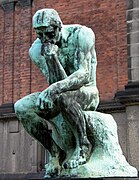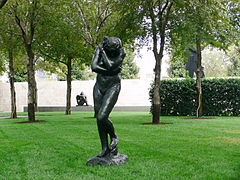Auguste Rodin



Auguste Rodin(bornFrançois-Auguste-René Rodin;12 November 1840 – 17 November 1917) was aFrenchsculptor.Rodin was born inParis.He made solid objects from stone orclay.His most famous works are 'The Thinker' and 'The Kiss'.
Although Rodin is generally considered the start of modern sculpture,[1]he did not set out to rebel against the past. His training was old-school. He took a craftsman-like approach to his work,[2]but he was rejected three times to Paris's foremost school of art.
Rodin had a unique ability to model a complex, turbulent, deeply pocketed surface inclay.Many of his most notable sculptures were roundly criticized during his lifetime. They clashed with the sculpturetradition,in which works were decorative, formulaic, or highly thematic.
Rodin's most original work departed from traditional themes ofmythologyandallegory.He modelled the human body withrealism,with individual character and physicality. Rodin refused to change his style. Gradually there came increasing favour from the government and the artistic community.
Hisstatueof writerHonoré de Balzacfor theSociété des Gens des Lettreswas heavily criticised. Rather than try to convince skeptics of its merit, Rodin repaid the Société his commission and moved the figure to his own garden. After this experience, Rodin did not complete another public commission. Only in 1939 wasMonumentto Balzac cast in bronze. It is now thought to be a masterpiece.[3]
Rodin's reputation grew, and he became the top French sculptor of his time. By 1900, he was a world-renowned artist. Rich private clients sought Rodin's work after his 1900World's Fairexhibit. For example, a Japanese patron,Matsukata Kojiro,paid for some of Rodin's best castings, including "The Gates of Hell."[4]
Rodin kept company with a variety of high-profile intellectuals and artists. He married his lifelong companion, Rose Beuret, in the last year of both their lives.
His sculpture suffered a decline in popularity after his death in 1917.
Gallery
[change|change source]-
The Thinker
-
Detail of "The Gates of Hell"
-
Head of Jean d'Aire
-
The Call to Arms
-
Eve, discovering shame. Another version is in the background.
-
The Burghers of Calais inWestminster,London. The statue commemorates six merchants ofCalaiswho offered themselves as hostages toEdward IIIafter he had besiegedtheir town for nearly a year in 1347.
Other websites
[change|change source]- Musée Rodin, Paris
- Rodin Museum, Philadelphia
- Views of the Musée RodinArchived2014-05-17 at theWayback Machine
- Rodin-Web.org: Academic site on Rodin
- Biography resources dedicated to Auguste RodinArchived2007-09-27 at theWayback Machine
- "Rodin at the V&A".Sculpture.Victoria and Albert Museum.Archived fromthe originalon 2008-02-12.Retrieved2007-09-01.
References
[change|change source]- ↑Tucker, William 1974.Early modern sculpture.New York: Oxford University Press.ISBN0-19-519773-9p16
- ↑Hale, William Harlan 1973 [1969].World of Rodin, 1840-1917.New York: Time-Life Books. LCCN 70-105511 p76
- ↑ Schor, Naomi 2001. Pensive texts and thinking statues: Balzac with Rodin.Critical Inquiry27(2): 239–264. doi:10.1086/449007.
- ↑Michener, James A. (1983).The Floating World,p. 244.






